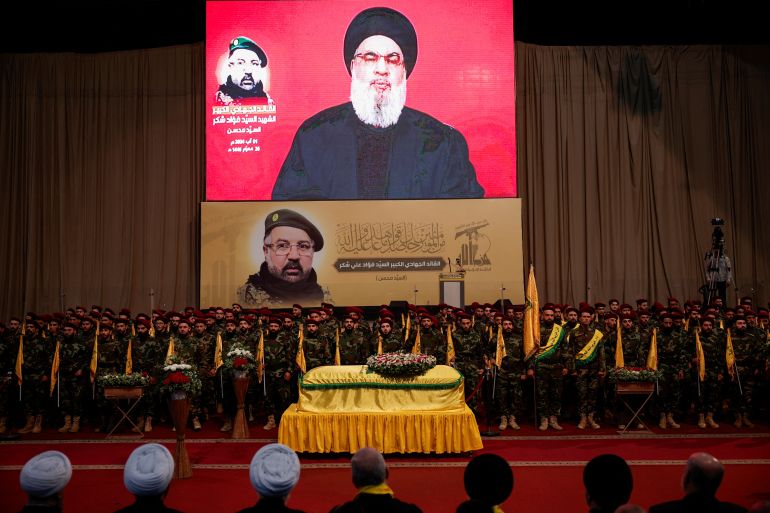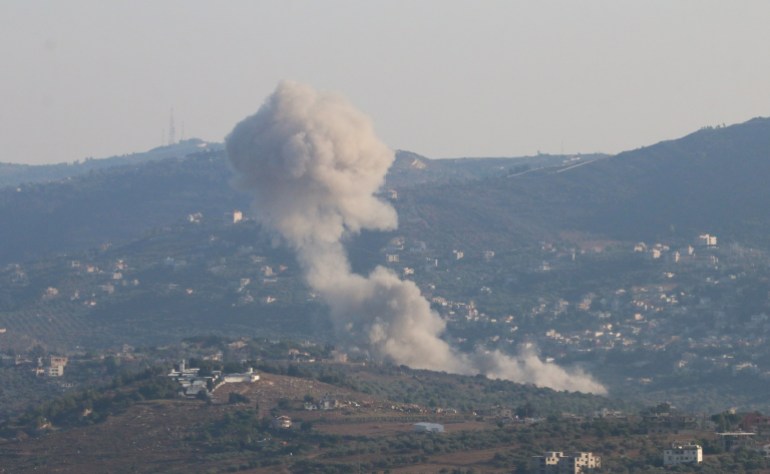Hezbollah’s tunnel video threatens enemies but leaves much unknown
The Lebanese group’s latest video unveils its expansive tunnel network, which it can use to its advantage against Israel.

The slickly made video shows fighters driving large trucks and motorbikes through well-lit underground roads.
Some of the trucks are carrying what appear to be missiles, and as the vehicles drive through, it becomes clear what the makers of the video – the Lebanese armed group Hezbollah – are unveiling: an extensive tunnel network used to store and launch missiles and what will surely be a vital resource in any conflict with Israel.
Keep reading
list of 3 itemsAs war looms over Lebanon, refugees wonder how they will survive
Blinken says ceasefire talks ‘maybe last’ chance to free captives from Gaza
The video, unveiled last week and titled Our Mountains, Our Treasures, serves as a warning that Hezbollah can use its expansive and concealed weapons arsenal to retaliate in kind against Israel if it launches a major operation against the group, analysts told Al Jazeera.
“This was a message to the Israelis [from Hezbollah]: We have barely scratched the surface of the type of damage we can inflict on you,” said Nicholas Blanford, an expert on Hezbollah and a fellow at the Atlantic Council, a think tank based in Washington, DC.
Since October 8, Hezbollah and Israel have been fighting a low-scale border conflict. The Lebanese movement has said its aim for now is to reduce pressure on Gaza, where Israel has killed more than 40,000 people and uprooted nearly all of its 2.3 million people in a war on the Palestinian enclave over the past 10 months.
The war began on October 7 after attacks led by the Palestinian group Hamas on southern Israel, during which 1,139 people were killed and about 250 were taken captive.
Hezbollah has long said that it would stop striking northern Israel if it agrees a ceasefire with Hamas in Gaza. But Israel has repeatedly impeded ceasefire attempts and instead escalated attacks on Hezbollah and Lebanese communities.
As fears of a regional conflict grow – particularly after the killings of Hezbollah’s number two commander Fuad Shukr and Hamas’s political leader Ismail Haniyeh last month – Hezbollah’s latest video aims to re-establish deterrence against Israel by illustrating its expansive and sophisticated combat capabilities, analysts said.
“This is all messaging to the Israelis not to underestimate us and that if you go too far, then we have plenty more capabilities to bring to the fore,” Blanford told Al Jazeera.

Psychological warfare
It should be noted that neither is there a way of knowing where the tunnels filmed in the video are nor how extensive Hezbollah’s tunnel network is.
In fact, all that can be known is the very little revealed in the video: that these tunnels exist, that they are large and serve as underground highways, that weapons are apparently stored in them and that they connect to openings above the ground where Hezbollah can fire from.
The limited information is, of course, intentional on the part of Hezbollah, a group that has to maintain secrecy in its military operations in the face of an enemy – Israel – that has far superior firepower and airpower.
And so, according to Michael Young, an expert on Lebanon and the broader region with the Carnegie Middle East Center, the video can be seen as part of a broader psychological war Hezbollah is waging against Israel.
Young believes that both sides have stepped up psychological warfare since the assassinations of Shukr and Haniyeh.
Israel admitted it killed Shukr in an air strike. It has not claimed or denied killing Haniyeh, but US and Iranian officials reportedly said Israel was responsible.
Both assassinations raised the temperature in the region and prompted Iran and Hezbollah to promise retaliation to restore deterrence.
Since then, Israel has threatened to use “bunker buster” bombs, which are designed to penetrate targets deep in the ground. Hezbollah responded to Israel’s threats by unveiling its latest video to show its expansive underground network.
Hamas’s own tunnel network in Gaza has proved to be effective in providing a refuge for fighters and leaders as well as a way to skirt past Israeli forces operating above ground and launch attacks.
Hezbollah’s underground facilities could prove even more effective because it is widely believed to have more advanced capabilities than Hamas.
“Both sides [Israel and Hezbollah] are playing a psychological game, partly to deter the other from their threats and from going too far,” Young told Al Jazeera. “I see this video mainly as an instrument of deterrence.”
In addition, Young said, Hezbollah and Iran have delayed their retaliation for the killings of Shukr and Haniyeh to buy time for ceasefire talks between Hamas and Israel to succeed.
Hezbollah, in particular, appears to be exerting leverage on the United States and Israel to agree to a ceasefire by showing its expansive arsenal. At the same time, Hezbollah and Iran have no immediate incentive to retaliate against Israel because it risks undermining the chances of a ceasefire in Gaza, Young explained.
“Hezbollah and Iran’s response – up to now – has taken time. While I still think they will respond, for now, they are using psychological warfare as leverage for the ceasefire talks. Both have an interest in seeing these talks succeed. They could then sell the ceasefire as a victory without actually getting involved in a war,” he said.
Domestic posturing
Hezbollah’s latest video may have also sent a reassuring message to its supporters in Lebanon, analysts told Al Jazeera.
Hezbollah’s constituents, in particular, may be discouraged that the group has yet to retaliate for the killing of Shukr despite its leader Hassan Nasrallah promising to do so in early August, according to Blanford.
“It seems Hezbollah won’t do anything while Gaza ceasefire talks are under way, but the group wanted to convey a sense of strength and resolve [with its latest video], partly to bolster their support base, who are saying: ‘Hey, you promised to retaliate,’” he told Al Jazeera.
Mohanad Hage Ali, an expert on Lebanon and a senior fellow with the Carnegie Middle East Center, told Al Jazeera that Hezbollah’s recent video will not by itself restore deterrence.
He added that Hezbollah has been trying to contain its conflict with Israel via the “rules of engagement” whereby both sides agree in principle not to target major residential areas or civilians.
But Israel, Hage Ali said, has routinely pushed or violated these red lines as it did by killing Shukr in Dahiya, a bustling residential area in the southern suburbs of Lebanon’s capital, Beirut.
“Hezbollah previously drew a red line on Israel targeting the southern suburbs of Beirut, but that has flown out the window,” he explained.
“Hezbollah’s lack of response shows that new rules of engagement have been accepted. Now, the organisation is trying to compensate its popular base for its lack of military action with this video.”
Blanford, however, believes the video is part of a broader strategy of deterrence that will eventually include an attack against Israel.
He noted that the missiles Hezbollah is currently using are “fairly basic” and its video reminds Israelis of what else it can use.
“The video seems to be communicating [to Israel] that we will retaliate and if you counter-retaliate too harshly, then these [are the weapons] we have in store for you,” Blanford said.